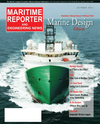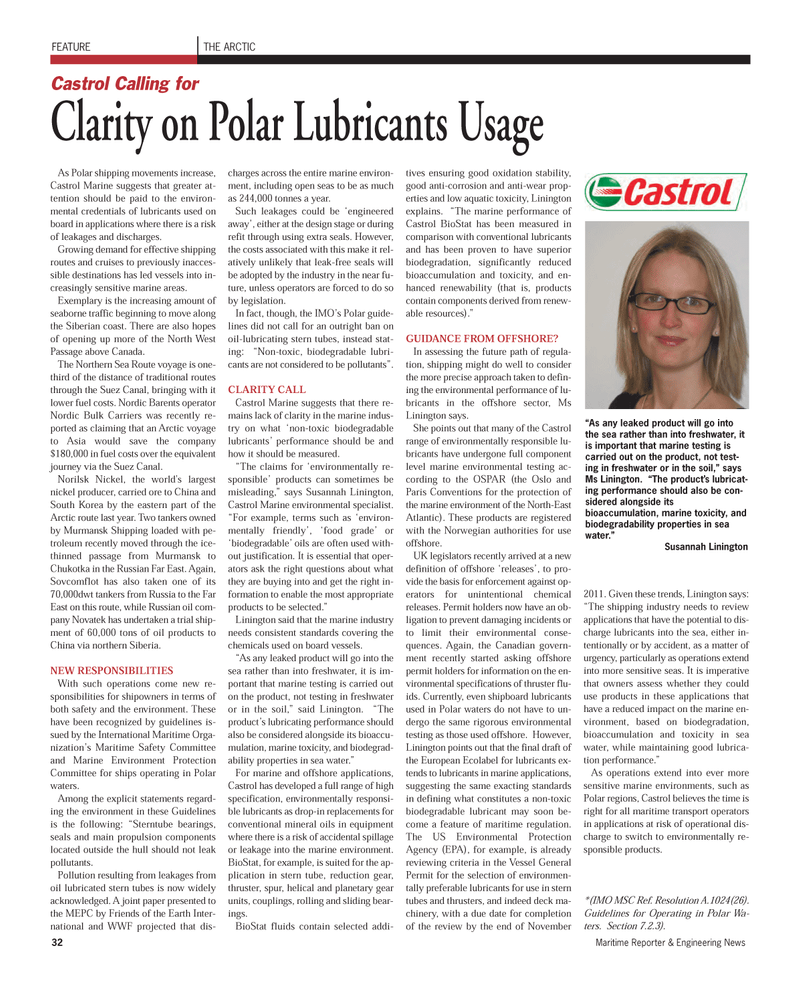
Page 32: of Maritime Reporter Magazine (October 2011)
Marine Design Annual
Read this page in Pdf, Flash or Html5 edition of October 2011 Maritime Reporter Magazine
As Polar shipping movements increase, Castrol Marine suggests that greater at-tention should be paid to the environ- mental credentials of lubricants used onboard in applications where there is a riskof leakages and discharges. Growing demand for effective shipping routes and cruises to previously inacces- sible destinations has led vessels into in- creasingly sensitive marine areas. Exemplary is the increasing amount of seaborne traffic beginning to move along the Siberian coast. There are also hopes of opening up more of the North West Passage above Canada. The Northern Sea Route voyage is one- third of the distance of traditional routesthrough the Suez Canal, bringing with itlower fuel costs. Nordic Barents operator Nordic Bulk Carriers was recently re- ported as claiming that an Arctic voyage to Asia would save the company $180,000 in fuel costs over the equivalent journey via the Suez Canal. Norilsk Nickel, the world's largest nickel producer, carried ore to China and South Korea by the eastern part of the Arctic route last year. Two tankers owned by Murmansk Shipping loaded with pe-troleum recently moved through the ice- thinned passage from Murmansk toChukotka in the Russian Far East. Again, Sovcomflot has also taken one of its 70,000dwt tankers from Russia to the Far East on this route, while Russian oil com-pany Novatek has undertaken a trial ship- ment of 60,000 tons of oil products toChina via northern Siberia.NEW RESPONSIBILITIESWith such operations come new re- sponsibilities for shipowners in terms ofboth safety and the environment. These have been recognized by guidelines is- sued by the International Maritime Orga- nization?s Maritime Safety Committee and Marine Environment Protection Committee for ships operating in Polarwaters. Among the explicit statements regard- ing the environment in these Guidelines is the following: ?Sterntube bearings, seals and main propulsion componentslocated outside the hull should not leakpollutants. Pollution resulting from leakages fromoil lubricated stern tubes is now widely acknowledged. A joint paper presented to the MEPC by Friends of the Earth Inter- national and WWF projected that dis- charges across the entire marine environ- ment, including open seas to be as muchas 244,000 tonnes a year. Such leakages could be ?engineeredaway?, either at the design stage or during refit through using extra seals. However, the costs associated with this make it rel- atively unlikely that leak-free seals will be adopted by the industry in the near fu-ture, unless operators are forced to do soby legislation. In fact, though, the IMO?s Polar guide- lines did not call for an outright ban onoil-lubricating stern tubes, instead stat-ing: ?Non-toxic, biodegradable lubri- cants are not considered to be pollutants?. CLARITY CALLCastrol Marine suggests that there re-mains lack of clarity in the marine indus-try on what ?non-toxic biodegradablelubricants? performance should be and how it should be measured. ?The claims for ?environmentally re- sponsible? products can sometimes bemisleading,? says Susannah Linington, Castrol Marine environmental specialist. ?For example, terms such as ?environ- mentally friendly?, ?food grade? or ?biodegradable? oils are often used with- out justification. It is essential that oper- ators ask the right questions about whatthey are buying into and get the right in- formation to enable the most appropriateproducts to be selected.? Linington said that the marine industryneeds consistent standards covering the chemicals used on board vessels. ?As any leaked product will go into the sea rather than into freshwater, it is im- portant that marine testing is carried outon the product, not testing in freshwater or in the soil,? said Linington. ?The product?s lubricating performance should also be considered alongside its bioaccu-mulation, marine toxicity, and biodegrad- ability properties in sea water.? For marine and offshore applications, Castrol has developed a full range of high specification, environmentally responsi- ble lubricants as drop-in replacements forconventional mineral oils in equipment where there is a risk of accidental spillageor leakage into the marine environment. BioStat, for example, is suited for the ap- plication in stern tube, reduction gear, thruster, spur, helical and planetary gear units, couplings, rolling and sliding bear- ings.BioStat fluids contain selected addi-tives ensuring good oxidation stability, good anti-corrosion and anti-wear prop-erties and low aquatic toxicity, Linington explains. ?The marine performance of Castrol BioStat has been measured incomparison with conventional lubricants and has been proven to have superior biodegradation, significantly reduced bioaccumulation and toxicity, and en- hanced renewability (that is, products contain components derived from renew- able resources).? GUIDANCE FROM OFFSHORE? In assessing the future path of regula- tion, shipping might do well to considerthe more precise approach taken to defin- ing the environmental performance of lu- bricants in the offshore sector, Ms Linington says. She points out that many of the Castrol range of environmentally responsible lu- bricants have undergone full component level marine environmental testing ac- cording to the OSPAR (the Oslo and Paris Conventions for the protection of the marine environment of the North-East Atlantic). These products are registered with the Norwegian authorities for use offshore. UK legislators recently arrived at a new definition of offshore ?releases?, to pro- vide the basis for enforcement against op- erators for unintentional chemicalreleases. Permit holders now have an ob- ligation to prevent damaging incidents or to limit their environmental conse- quences. Again, the Canadian govern- ment recently started asking offshore permit holders for information on the en-vironmental specifications of thruster flu- ids. Currently, even shipboard lubricants used in Polar waters do not have to un- dergo the same rigorous environmental testing as those used offshore. However, Linington points out that the final draft of the European Ecolabel for lubricants ex- tends to lubricants in marine applications,suggesting the same exacting standards in defining what constitutes a non-toxic biodegradable lubricant may soon be- come a feature of maritime regulation. The US Environmental Protection Agency (EPA), for example, is already reviewing criteria in the Vessel General Permit for the selection of environmen- tally preferable lubricants for use in sterntubes and thrusters, and indeed deck ma-chinery, with a due date for completion of the review by the end of November 2011. Given these trends, Linington says: ?The shipping industry needs to review applications that have the potential to dis- charge lubricants into the sea, either in- tentionally or by accident, as a matter ofurgency, particularly as operations extend into more sensitive seas. It is imperative that owners assess whether they could use products in these applications thathave a reduced impact on the marine en- vironment, based on biodegradation, bioaccumulation and toxicity in seawater, while maintaining good lubrica- tion performance.? As operations extend into ever more sensitive marine environments, such as Polar regions, Castrol believes the time is right for all maritime transport operatorsin applications at risk of operational dis-charge to switch to environmentally re- sponsible products. *(IMO MSC Ref. Resolution A.1024(26). Guidelines for Operating in Polar Wa- ters. Section 7.2.3). 32Maritime Reporter & Engineering News THE ARCTICFEATURE Castrol Calling for Clarity on Polar Lubricants Usage ?As any leaked product will go into the sea rather than into freshwater, it is important that marine testing is carried out on the product, not test- ing in freshwater or in the soil,? says Ms Linington. ?The product?s lubricat- ing performance should also be con- sidered alongside its bioaccumulation, marine toxicity, and biodegradability properties in sea water.? Susannah Linington MR Oct.11 # 4 (25-33):MR Template 10/6/2011 4:22 PM Page 32

 31
31

 33
33
